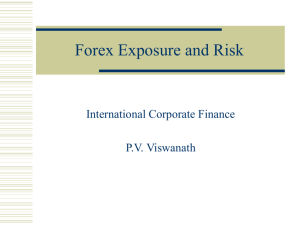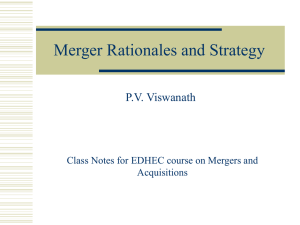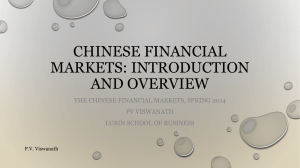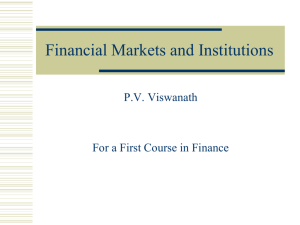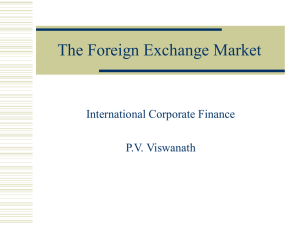Global Financial Structure
advertisement
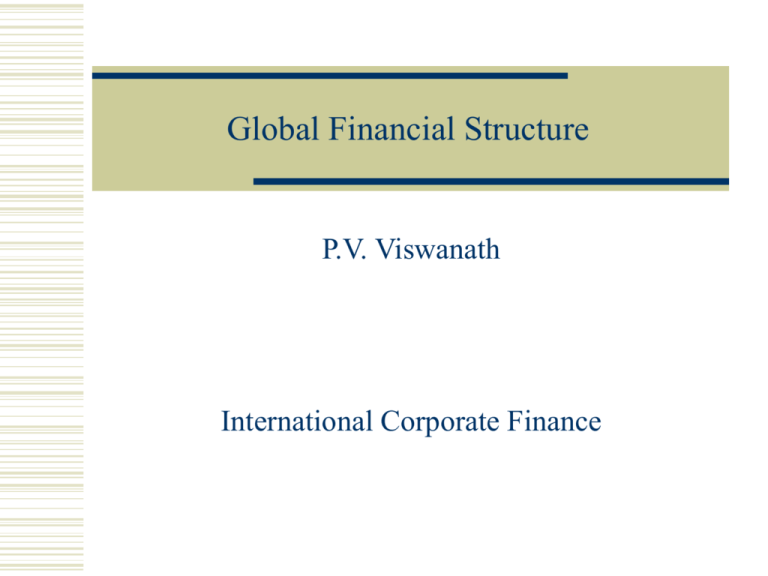
Global Financial Structure P.V. Viswanath International Corporate Finance The cost of staying domestic Firms that are forced to source their long-term debt and equity in a highly illiquid domestic securities market will have a relatively high cost of capital and limited availability of capital. P.V. Viswanath 2 Dimensions of Cost and Availability P.V. Viswanath 3 Segmented Capital Markets Capital Markets become segmented because of market imperfections, such as: Regulatory Controls Perceived Political Risk Foreign Exchange Risk Lack of Transparency Asymmetric Information Cronyism Insider Trading P.V. Viswanath 4 Estimating the Global Cost of Equity for Nestlé in Swiss Francs Question: Would an MNE with access to global capital always have a lower cost of capital than if it were restricted to domestic sources? P.V. Viswanath 5 Market Segmentation and Market Efficiency A market is segmented if the required rate of return on securities in that market differs from the required rate of return on securities of comparable risk that are traded on other national securities markets. A market is efficient if security prices in that market reflect all available information. Although segmented markets are likely to be inefficient, the two concepts are independent. If security prices in a segmented market reflect all relevant local information, that market would indeed be efficient. However, foreign investors would not be participants in such a market. P.V. Viswanath 6 Global Sourcing and Lower Capital Costs Local capital markets are likely to be smaller. Hence, a firm that begins with a domestic capital market and is forced to raised its capital locally will, after a while, find that it has to pay a high price for its capital needs. If it can access global markets, it can raise funds at a cheaper rate for those additional capital needs. P.V. Viswanath 7 Global Sourcing and Lower Capital Costs Marginal Return on Investments Local Marginal Cost of Capital C B Global Marginal Cost of Capital A Budget P.V. Viswanath 8 Global Sourcing and Lower Capital Costs However, this cannot be guaranteed once the domestic capital market becomes completely integrated into the global market. If investors in the domestic market do not have access to a global market as well, they are essentially forced to invest locally and may be satisfied with a lower rate of return. Hence it may be optimal for the global firm to tap the cheaper local markets for its initial capital requirements, and go global only once its needs get so great that it would be very expensive to continue to use local markets P.V. Viswanath 9 Global Sourcing and Lower Capital Costs Once the domestic market becomes completely integrated into global markets, investors will demand the higher rates of return that may be available in global markets. This would rob the firm of the originally available bargain sources of capital. Local business may be hurt, especially those with monopolies, along with their owners and employees. However, local investors will be better off. P.V. Viswanath 10 Global Sourcing and the Price of Risk The slope of a market’s capital allocation line represent the reward to risk ratio in that market Global Efficient Frontier Domestic Efficient Frontier Standard Deviation of Returns P.V. Viswanath 11 Global Sourcing and the Price of Risk The price of risk for the firm with global options can be lower at higher risk levels Global Efficient Frontier Domestic Efficient Frontier Standard Deviation of Returns P.V. Viswanath 12 Global Sourcing and Investment Choices If a firm has access to global sources of capital, it can make different decisions regarding the choice of projects and their riskiness It can also make different decisions regarding capital structure. For example, If it can sell off its assets in more liquid markets, its bankruptcy costs would be lower. If it can reorganize cheaper, its bankruptcy costs would be lower. If debt is cheaper relative to equity in global markets In such a case, the firm would choose more debt. P.V. Viswanath 13



